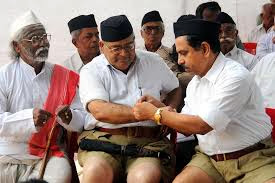'Raksha Bandhan' is a special occasion to celebrate the emotional bond of love between a brother and a sister, by tying a holy thread called ‘Rakhi’ around the right wrist of the brother. It signifies that the strong must protect the weak from all that’s evil. It is primarily observed in India, Mauritius, Nepal and in some parts of Pakistan by Hindus,Jains, and most Sikhs.
Gurudev Rabindra Nath Tagore's vision of celebrating Raksha Bandhan was totally different. According to him Rakhi was not only a festival of the siblings but it's a celebration of mankind and of humanity. He believed that it is the responsibility of all the members of the society to help and protect each other and encourage a harmonious social life. For himRaksha bandhan festival was the celebration of fellow feelings and concerns.
In 1905 when the British decided to divide Bengal on the basis of religion RabindraNath Tagore organised a ceremony to celebrate Raksha Bandhan to strengthen the bond of love and togetherness among Hindus and Muslims of Bengal in their fight against the Britishempire. He used the platform of Raksha Bandhan to spread the feeling of brotherhood, nationalist spirit among people from different ethnic groups. In Shantiniketan he started congregations like Rakhi Mahotsava to invoke trust and feeling of peaceful coexistence. The tradition continues today as people tie rakhis to their neighbours and close friends.
Raksha Bandhan is observed on the full moon day of the Hindu month of Shravanwhen sisters tie the sacred Rakhi thread on their brothers' wrist and pray for their long life.Rakhis come in many colors and designs and are ideally made of silk with gold and silver threads, beautifully studded with semi precious stones. The brother in return offers gift to his sister and vows to look after her as she presents sweets to him.
In Northern India, Rakhi Purnima is also called Kajri Purnima or Kajri Navami, when wheat or barley is sown, and goddess Bhagwati is worshipped. In Western states, the festival is called Nariyal Purnima or the Coconut Full Moon. In Southern India, ShravanPurnima is an important religious occasion.
Historically the strong bond represented by Rakhi had resulted in innumerable political ties among kingdoms and princely states. Indian history testify that the Rajput and Maratha queens sent Rakhis even to Mughal kings who despite their differences offered them help and protection at critical moments and honoured their brotherly commitments. It is said that the great Hindu King Porus refrained from striking Alexander, the Great because the latter’s wife had tied a Rakhi on his hand, prior to the battle, urging him not to hurt her husband.
So if we look into the actual significance of this festival in today's world, which is full of crisis and strife, such rituals hold the key to peaceful existence. The auspicious day ofRaksha Bandhan can be used as an occasion for social change, which could ultimately unite people in a permanent bond of love and friendship. Rabindra Nath Tagore used white threads for Raksha Bandhan and made white Raksha Bandhan popular among Friends. His poem on Raksha Bhandan: "Banglar mati Banglar jal (May the Earth and Water of Bengal be blessed, O Lord)) signifies his love for motherland and people.






